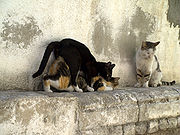
Lordosis behavior
Encyclopedia

Mammal
Mammals are members of a class of air-breathing vertebrate animals characterised by the possession of endothermy, hair, three middle ear bones, and mammary glands functional in mothers with young...
s, such as mice
Mouse
A mouse is a small mammal belonging to the order of rodents. The best known mouse species is the common house mouse . It is also a popular pet. In some places, certain kinds of field mice are also common. This rodent is eaten by large birds such as hawks and eagles...
and cat
Cat
The cat , also known as the domestic cat or housecat to distinguish it from other felids and felines, is a small, usually furry, domesticated, carnivorous mammal that is valued by humans for its companionship and for its ability to hunt vermin and household pests...
s, that consists of a ventral arching of the spine
Vertebral column
In human anatomy, the vertebral column is a column usually consisting of 24 articulating vertebrae, and 9 fused vertebrae in the sacrum and the coccyx. It is situated in the dorsal aspect of the torso, separated by intervertebral discs...
. During lordosis, the spine curves so that the apex points in the ventral direction. That is, the spine arches inward toward the abdomen.
Lordosis aids in copulation, as it elevates the hips to allow for intercourse. It is commonly seen in females during estrus. It changes the pelvic tilt
Pelvic tilt
The concept of pelvic tilt in anatomy refers to the orientation of the pelvis in respect to the femurs it rests upon and in space. It can tilt in four basic directions.-Forms:...
in an anterior way, with the posterior pelvis rising up, the bottom angling backward and the front angling downward.
During estrus in female mice, the hormone
Hormone
A hormone is a chemical released by a cell or a gland in one part of the body that sends out messages that affect cells in other parts of the organism. Only a small amount of hormone is required to alter cell metabolism. In essence, it is a chemical messenger that transports a signal from one...
estradiol
Estradiol
Estradiol is a sex hormone. Estradiol is abbreviated E2 as it has 2 hydroxyl groups in its molecular structure. Estrone has 1 and estriol has 3 . Estradiol is about 10 times as potent as estrone and about 80 times as potent as estriol in its estrogenic effect...
(a hormone of the class of hormones known as estrogen
Estrogen
Estrogens , oestrogens , or œstrogens, are a group of compounds named for their importance in the estrous cycle of humans and other animals. They are the primary female sex hormones. Natural estrogens are steroid hormones, while some synthetic ones are non-steroidal...
s) affects neuron
Neuron
A neuron is an electrically excitable cell that processes and transmits information by electrical and chemical signaling. Chemical signaling occurs via synapses, specialized connections with other cells. Neurons connect to each other to form networks. Neurons are the core components of the nervous...
s in the ventromedial hypothalamus
Hypothalamus
The Hypothalamus is a portion of the brain that contains a number of small nuclei with a variety of functions...
, the periaqueductal gray
Periaqueductal gray
Periaqueductal gray is the gray matter located around the cerebral aqueduct within the tegmentum of the midbrain. It plays a role in the descending modulation of pain and in defensive behaviour...
, and other areas of the brain
Brain
The brain is the center of the nervous system in all vertebrate and most invertebrate animals—only a few primitive invertebrates such as sponges, jellyfish, sea squirts and starfishes do not have one. It is located in the head, usually close to primary sensory apparatus such as vision, hearing,...
. Sexual stimuli trigger activity in a number of brain areas, including the ventromedial hypothalamus, which sends impulses down axons synapsing with neurons in the periaqueductal gray. These convey an impulse to neurons in the medullary reticular formation
Reticular formation
The reticular formation is a part of the brain that is involved in actions such as awaking/sleeping cycle, and filtering incoming stimuli to discriminate irrelevant background stimuli...
which project down the reticulospinal tract
Reticulospinal tract
The reticulospinal tract is an extrapyramidal motor tract which travels from the reticular formation.-Functions:...
and synapse with afferent neurons in the spinal cord
Spinal cord
The spinal cord is a long, thin, tubular bundle of nervous tissue and support cells that extends from the brain . The brain and spinal cord together make up the central nervous system...
(L1-L6) which contract muscles along the spine to exhibit the lordosis posture. Since these afferent neurons are also part of a reflex arc
Reflex arc
A reflex arc is a neural pathway that controls an action reflex. In higher animals, most sensory neurons do not pass directly into the brain, but synapse in the spinal cord...
, lordosis can also be triggered reflex
Reflex
A reflex action, also known as a reflex, is an involuntary and nearly instantaneous movement in response to a stimulus. A true reflex is a behavior which is mediated via the reflex arc; this does not apply to casual uses of the term 'reflex'.-See also:...
ively.
The anthropologist Helen Fisher
Helen Fisher (anthropologist)
Helen E. Fisher is a Canadian-American anthropologist and human behavior researcher. She is professor at Rutgers University. Fisher has studied romantic interpersonal attraction for over 30 years. Prior to becoming a research professor at Rutgers University, she was a research associate at the...
speculates that women wearing high heels demonstrate lordosis behavior.

